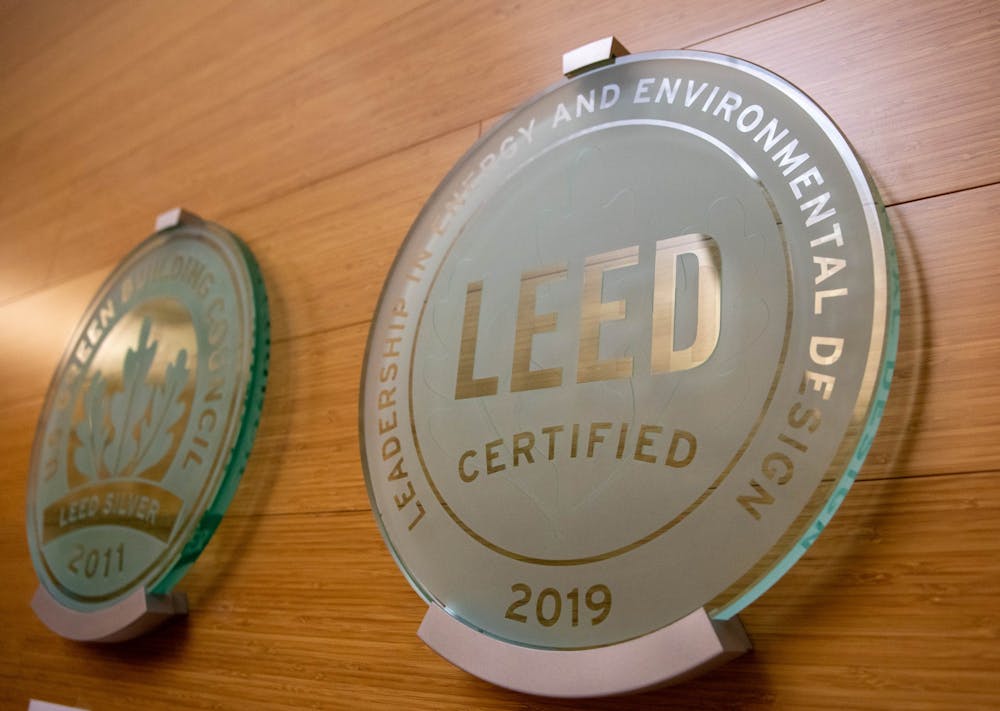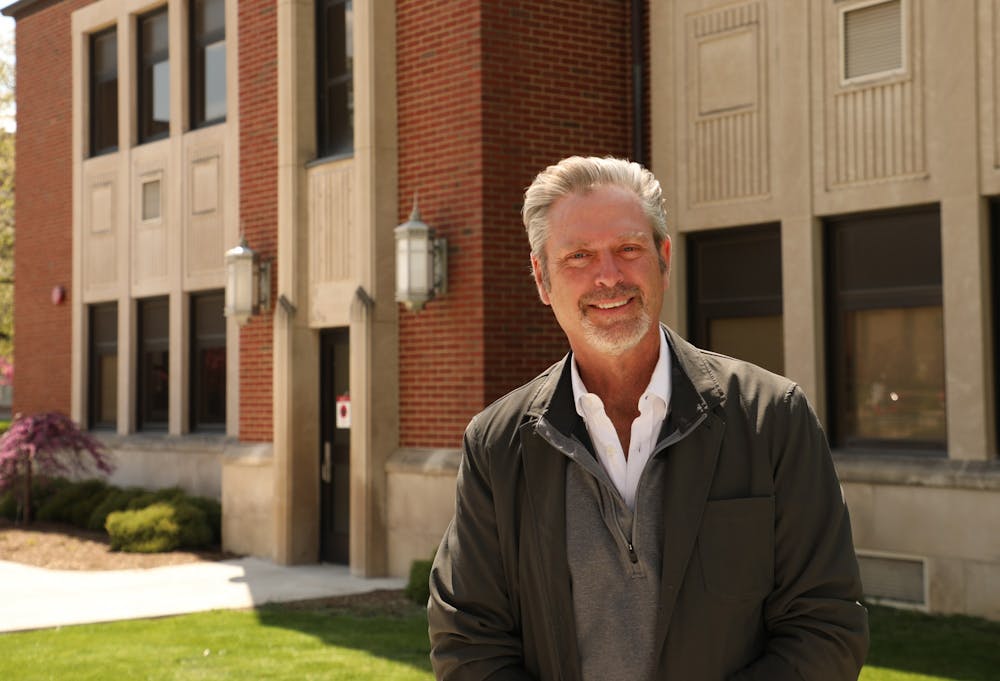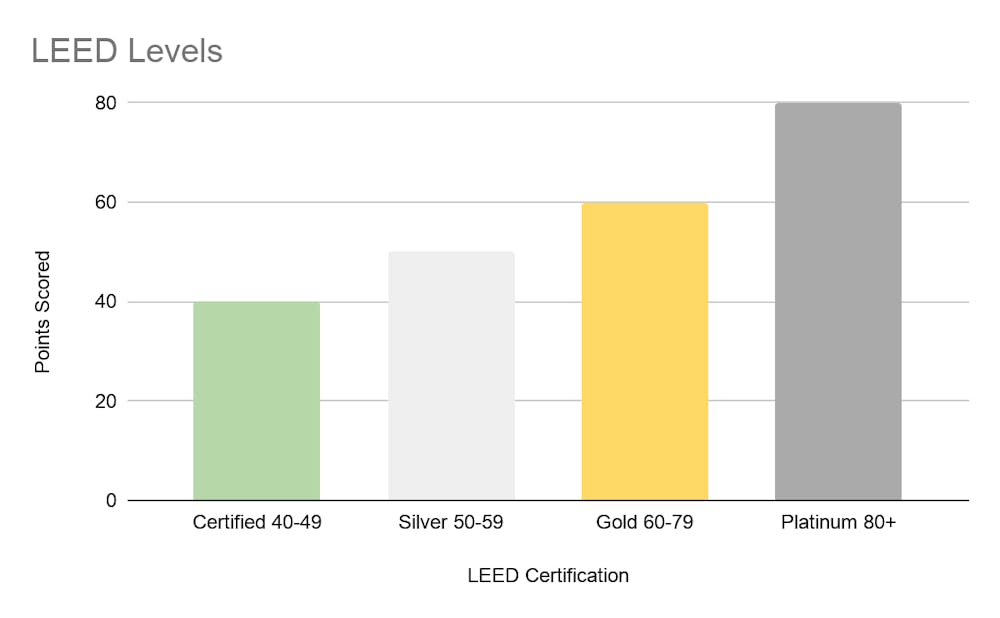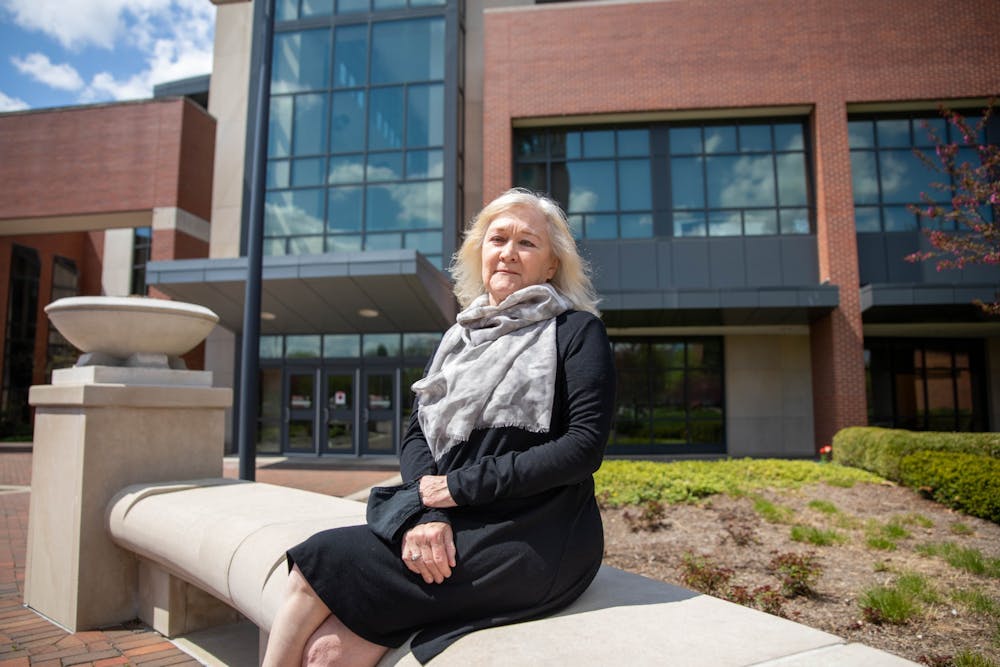The Applied Technology Building isn’t a very impressive structure from the standpoint of height. Most mornings, it is quite literally in the shadow of the Teachers College. Yet there is one aspect of the Applied Technology Building that sets it apart from most other buildings on campus — it is one of only seven buildings on campus with a Leadership in Energy and Environmental Design (LEED) Gold rating.
On campus, 16 buildings play a silent, often forgotten, role — emission reduction. It is no secret these buildings are LEED-certified, but the small plaques left to honor the accomplishment are easy to miss, and in some cases, not even displayed at all.
LEED is a rating system in which a building will earn points for environmentally-friendly design elements. This point system includes considerations for energy and water use, pollution reduction and various other design aspects.
Robert Koester, professor of architecture and director of Ball State’s Center for Energy Research, Education, and Service (CERES) has played a key role in keeping the university’s campus buildings eco-friendly.
Koester said one of the core factors in LEED certification is energy usage.
“If you build a more energy efficient building, [requiring] less energy to heat, cool and light, then some of the impact is local and some of it is regional,” Koester said. “You have [a] ripple effect, [starting] at the location of the building and then, further out in the region with reduction in demand for [oil or coal] power.”
In addition to being the director of CERES, Koester is also a founding chair of the campus Council on the Environment (COTE). According to COTE’s website, its goal is to provide leadership for initiatives that encourage sustainable use of resources and the protection of ecosystems.
Koester said the university should continue to improve its standards in considering LEED building certifications. He said COTE passed a resolution before the Health Professions Building opened that declared it should be a LEED Zero building, which would require a 12-month period of net-zero carbon emissions, power consumption, water usage and a LEED Platinum certification in waste management. Koester said the building only earned a LEED Gold certification due to budgeting issues.

The original Leadership in Energy and Environmental Design (LEED) certification (left) hangs next to the student-achieved LEED certification April 21, 2021, inside the David Letterman Communication and Media Building. The student-achieved LEED certification was the fifth of its kind worldwide. Jaden Whiteman, DN
Budget issues often are a factor when attempting to apply for LEED certifications, Koester said. He said, in his opinion, the new Multicultural Center should have been the first LEED Platinum building on campus, but due to issues with the budget, it was never seriously pursued. Koester said he hopes it will receive a LEED Gold certification, but it is unclear at this time what certification it will receive.
Koester isn't alone in his belief that building green is the way to go. Timothy Gray, professor of architecture and former state board of directors for the U.S. Green Building Council (USGBC), said he would also love to see the university improve upon its LEED standards.
“Their goal right now [is] LEED Silver. I'd love to see them up it to LEED Gold [and] to see the standards continued to be applied and stretched and used to illustrate the benefits of sustainable practices,” Gray said.
Gray said LEED is more than just good for the environment, it's good for business.
“There's data now that supports that workers are more productive and have less sick days, and all of that builds a very strong case that [LEED standards] are not just environmental standards that are good for the public in general, but the adoption of the standards makes good business sense,” Gray said.
Gray said the fact that Ball State is a leader in LEED regionally and nationally gives him “tremendous pride” and institutions like Ball State set a standard for others to follow.

Timothy Gray, professor of architecture, poses for a photo outside of the Applied Technology Building. The Applied Technology Building is one of 16 Leadership in Energy and Environmental Design (LEED)-certified buildings on campus. Rylan Capper, DN
Faculty and staff aren't the only ones on campus making an impact with LEED. In November 2019, Ball State celebrated as it became the fifth university in the world to achieve certification through the USGBC’s LEED Lab program.
The team of construction management students, under the guidance of Janet Fick, achieved a LEED Operations and Maintenance (LEED O+M) certification for the Letterman Building, successfully accumulating 47 points overall, most of which came from water efficiency. LEED O+M is a certification existing buildings can receive if a team can prove their building meets minimum requirements and point values.
Fick, associate lecturer of construction management and instructor for LEED Lab, said she's instructed 127 students throughout her time teaching the class since 2015. She said, so far, there have been two successful attempts at getting LEED O+M certifications on campus, the David Letterman Communication and Media Building in July 2019 and the Glick Center for Glass in December 2020.

Each level of LEED certification requires a certain number of total points based on evaluations of water efficiency, indoor environmental quality, maintenance operations and other factors. Janet Fick, associate lecturer of construction management and instructor for LEED Lab, led a team of students to earning a LEED Operations and Maintenance certification for the David Letterman Communication and Media Building in July 2019. Eli Houser, DN Illustration
“[LEED Lab] shows the commitment Ball State has made to sustainability,” she said. “I've been the lead faculty on [LEED Lab] throughout, and they've always given me their full support.”
Fick, also a LEED-accredited professional, said she believes her class can be a source of pride for students on campus.
“Some of [the students] might think they didn't do much, but every little piece is important, and everybody is part of the success of the project,” Fick said.
Fick said there are currently two projects the lab is involved with — the Applied Technology Building LEED O+M certification and the new Multicultural Center LEED certification. She said students looking to get involved in her elective class will have to wait until the fall 2022 semester because her class for this coming fall semester is already filled.
“I was a little worried about this fall since I'm not going into the building every day, but apparently [it wasn't] a problem, kids want to be involved in LEED Lab,” Fick said. “It's something good to put on a resume because it's not ‘I learned about,’ it's ‘I actively helped the certification of a LEED project’ — I think that's why I have such good support.”
Koester said in addition to the buildings on campus already LEED-certified, Ball State will add the new Multicultural Center with a LEED Silver certification, and the Foundational Science Building with a LEED Gold certification.
Koester said the next big environmental goal for Ball State is to find a green alternative for the campus’ power needs.
“Our next step ... is to establish [a] virtual power purchase agreement with a developer somewhere out in the country who will construct either a solar farm or a wind farm [to] produce electrical power equal to the demand of our campus.”
Contact Eli Houser with comments at ejhouser@bsu.edu.




